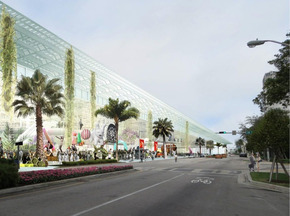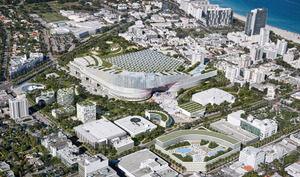The WPJ
THE WORLD PROPERTY JOURNALReal Estate Facts Not Fiction
Featured Columnists

Miami Beach Chooses Rem Over Bjarke
Commercial News » Global Property Beat | By Kevin Brass | July 19, 2013 10:33 AM ET
If designing urban spaces was a spinoff of "Game of Thrones," the Rem Koolhaas-Bjarke Ingels confrontation in Miami Beach would be a great storyline.
After months of scandal and castle intrigue, the city this week chose a development team led by the legendary Koolhaas to redevelop its 52-acre convention center district, spurning the competing team led by Koolhaas' former employee, the young upstart Bjarke Ingels.
The master vanquished the student. Obi-Wan beat Luke. Even Ingels referred to the competition as "Oedipal."
It made for a good theater, but the convention center project-- repeatedly described by the local paper as "one of the most significant urban projects in the country" -- was never about great urban design. As is often the case in these types of projects, the commercial public-private partnership process was clearly focused on trying to find an economical way to redevelop the land and build a mega convention center to compete with all the other mega convention centers.
Yet, for many observers, it was hard not to put this internationally-tracked project in terms of the two architects and the fascination of seeing Koolhaas' OMA and Ingels' modestly-named BIG (Bjarke Ingels Group) participating in a lengthy head-to-head competition for a $1 billion development. It was easy to frame it as Rem versus Bjarke.
Koolhaas is destined to go down as one of the great innovators and stylists of modern architecture, a true icon of the industry, one of the handful of architects always sure to generate passion and debate. Ingels is the brash kid with a flair for drama and good TV, a fellow Scandanavian and innovator, only now entering the big stage, winning the type of commissions that seal his status as a player.
 Little of that flair is evident in their Miami Beach designs. Both OMA and BIG produced workable solutions, suggesting plans that create public spaces while generating revenue for the developers and city. With a myriad of traffic issues, tight economics and detailed requirements for the centerpiece convention center, there were few options on the table for the architects.
Little of that flair is evident in their Miami Beach designs. Both OMA and BIG produced workable solutions, suggesting plans that create public spaces while generating revenue for the developers and city. With a myriad of traffic issues, tight economics and detailed requirements for the centerpiece convention center, there were few options on the table for the architects.OMA and BIG produced the requisite pretty renderings and eco-friendly videos, but neither design would be characterized as inspired. Any slivers of revolution were squashed in the meat grinder community process. The City of Miami Beach added its own unique flair, including the arrest of the lead city administrator on corruption charges and a last minute move to downsize the plan.
Ultimately, the debate centered on such issues as the amount of revenue generated for the city and whether or not the convention center would stay open during construction. South Beach ACE, the development team led by Tishman Realty, won based on economic variables, not because Mr. Koolhaas proposed a vision that will transform the city.
"A renovated convention center, adjacent hotel, and re-imagined convention center campus are critical to Miami Beach's ability to maintain and grow its desirability as a tourism and convention destination," Dan Tishman, South Beach ACE's principal, said in a victory statement, which sounded very un-Koolhaas.
 Mr. Ingels can take solace in knowing he has two other projects in development in south Florida, including The Grove, a pair of twisting residential towers, which broke ground earlier this year.
Mr. Ingels can take solace in knowing he has two other projects in development in south Florida, including The Grove, a pair of twisting residential towers, which broke ground earlier this year.So what now for Miami Beach's grand plan?
The city must still figure out how to finance its portion of the deal, something close to $600 million. It's hoping to extend a special tax in the area, but there is nothing firm. The city must also negotiate a development deal with Tishman.
If all the deals are finalized, the plans will ultimately go to a public vote, which may require a "super-majority" to win approval, if an initiative drive is successful.
In other words, after all the intrigue and Oedipal conflict, neither Koolhaas nor Ingels may see their grand schemes become a reality.
Video: OMA's plan
Video: BIG's plan
Sign Up Free | The WPJ Weekly Newsletter
Relevant real estate news.
Actionable market intelligence.
Right to your inbox every week.
Real Estate Listings Showcase
Related News Stories
Featured Columnists Real Estate Headlines
- 2025 Prediction: U.S. Commercial Investment Recovery Expected to Gain Traction
- Holiday Retail Sales for 2024 to Hit Record $1 Trillion
- Tech, AI Industries Drive Largest Share of Office Leasing Activity in U.S.
- Commercial Real Estate Lending in U.S. Enjoys Strong Growth in Q3
- U.S. Multifamily Market Begins Recovery in Q3
- Commercial Investment in Japan Spikes 24 Percent Annually in Q3
- Despite Return-to-Office Mandates, U.S. Office Vacancies Continue to Rise
- PROPSIG Tech Startup Acquired by World Property Data
- U.S. Commercial Mortgage Debt Hits $4.7 Trillion in Q2 as Delinquencies Increase
- Hong Kong Class A Office Rents Continue to Downtick in Mid-Summer
- U.S. Office Landlords Tenant Concessions Decline for First Time in 4 Years
- U.S. Commercial Mortgage Originations Spike 27 Percent in Q2 Over Q1
- Phnom Penh's Commercial Office, Retail Markets Face Slowdowns in 2024
- Global Edge Data Center Market to Hit $300 Billion by 2026
- Commercial Property Transactions in Japan Dive 25 Percent Annually in Q2
- Delinquency Rates for U.S. Commercial Property Loans Downticks in Q2
- Megawarehouse Lease Deals in U.S. Increase in 2024
- Office Tenants' Flight to Quality Buildings Increases in 2024
- Commercial Lending in Japan Upticks 6 Percent Annually in Q1
- AI Driving Significant Global Data Center Growth in 2024
- Total U.S. Commercial Mortgage Debt Rises to $4.7 Trillion in Q1
- U.S. Commercial Mortgage Delinquencies Rise in Early 2024
- Asia Pacific Office Sector to Further Reprice Throughout 2024
- U.S. Retail Foot Traffic to Surpass Pre-Pandemic Levels by 2025
- Commercial Real Estate Lending in U.S. Slowed in First Quarter
- Japan Commercial Property Investment Volume Jumps 7 Percent in Q1
- Asia Pacific Commercial Property Investment Leads the World, Spikes 13 Percent
- Driven by High Rates, U.S. Commercial Lending Imploded 47 Percent in 2023
- After Two Year Slump, Prime Multifamily Metrics Uptick in U.S.
- Commercial Co-Broker Commissions Not Affected by NAR-DOJ Settlement, Yet
- U.S. Office Buildings with Upscale Tenant Amenities Still Enjoy Premium Rents in 2024
- U.S. Commercial, Multifamily Mortgage Delinquency Rates Uptick in Q4
- U.S. Commercial Mortgage Debt Continued to Rise in 2023, Hits $4.7 Trillion
- Nonresidential Construction Spending in the U.S. Falls Sharply in January
- U.S. Multifamily Construction Starts to Decline in 2024
- Commercial Mortgage Lending in U.S. Shows Signs of Stabilization in Late 2023
- Architecture Billings Decline in December as Soft Business Conditions Persist
- Government Sector Claimed Largest Portion of 100 Biggest U.S. Office Leases Signed in 2023
- U.S. Commercial, Multifamily Borrowing Dives 25 Percent Annually in Late 2023
- Record High Multifamily Construction Deliveries Drive Vacancy Rates Higher
Reader Poll
Marketplace Links
This website uses cookies to improve user experience. By using our website you consent in accordance with our Cookie Policy. Read More





